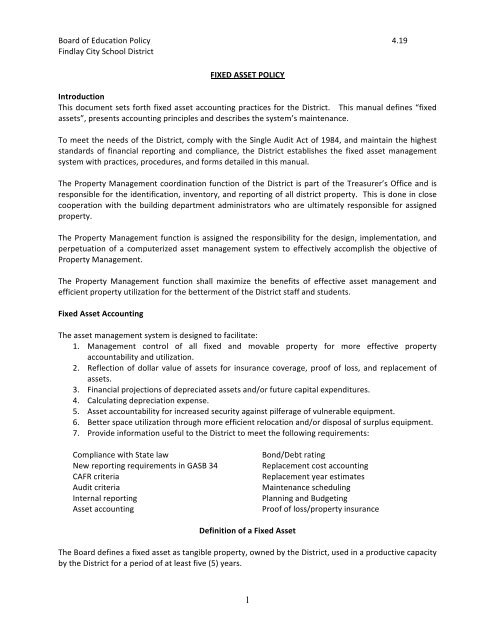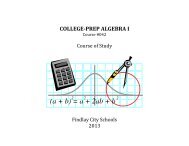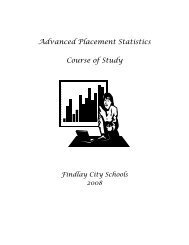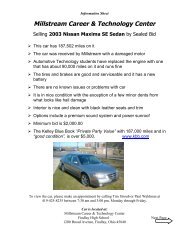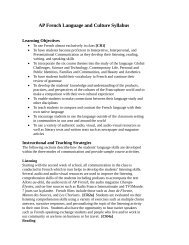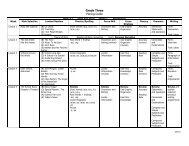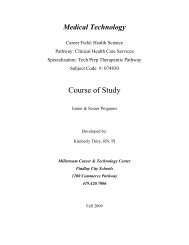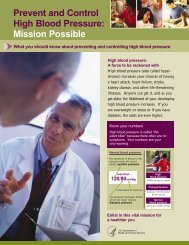Fixed Asset Policy - Findlay City Schools
Fixed Asset Policy - Findlay City Schools
Fixed Asset Policy - Findlay City Schools
You also want an ePaper? Increase the reach of your titles
YUMPU automatically turns print PDFs into web optimized ePapers that Google loves.
Board of Education <strong>Policy</strong> <strong>Findlay</strong> <strong>City</strong> School District 4.19 FIXED ASSET POLICY Introduction This document sets forth fixed asset accounting practices for the District. This manual defines “fixed assets”, presents accounting principles and describes the system’s maintenance. To meet the needs of the District, comply with the Single Audit Act of 1984, and maintain the highest standards of financial reporting and compliance, the District establishes the fixed asset management system with practices, procedures, and forms detailed in this manual. The Property Management coordination function of the District is part of the Treasurer’s Office and is responsible for the identification, inventory, and reporting of all district property. This is done in close cooperation with the building department administrators who are ultimately responsible for assigned property. The Property Management function is assigned the responsibility for the design, implementation, and perpetuation of a computerized asset management system to effectively accomplish the objective of Property Management. The Property Management function shall maximize the benefits of effective asset management and efficient property utilization for the betterment of the District staff and students. <strong>Fixed</strong> <strong>Asset</strong> Accounting The asset management system is designed to facilitate: 1. Management control of all fixed and movable property for more effective property accountability and utilization. 2. Reflection of dollar value of assets for insurance coverage, proof of loss, and replacement of assets. 3. Financial projections of depreciated assets and/or future capital expenditures. 4. Calculating depreciation expense. 5. <strong>Asset</strong> accountability for increased security against pilferage of vulnerable equipment. 6. Better space utilization through more efficient relocation and/or disposal of surplus equipment. 7. Provide information useful to the District to meet the following requirements: Compliance with State law New reporting requirements in GASB 34 CAFR criteria Audit criteria Internal reporting <strong>Asset</strong> accounting Bond/Debt rating Replacement cost accounting Replacement year estimates Maintenance scheduling Planning and Budgeting Proof of loss/property insurance Definition of a <strong>Fixed</strong> <strong>Asset</strong> The Board defines a fixed asset as tangible property, owned by the District, used in a productive capacity by the District for a period of at least five (5) years. 1
Board of Education <strong>Policy</strong> <strong>Findlay</strong> <strong>City</strong> School District 4.19 The following types of assets are included in the <strong>Fixed</strong> <strong>Asset</strong> Definition: 1. Capital <strong>Asset</strong>s a. have a value of $2,500 or more b. have a useful life of five years or more c. must meet the definition of one of the major <strong>Asset</strong> Classes of Land, Land Improvement, Building, Building Additions, Building Improvements, Furniture-‐Fixtures & Equipment, Capital Leases, Vehicles, Infrastructure and Construction in Progress d. must be of a tangible, distinguishable nature (possess unique physical substance) e. are not repair parts, component parts, or supplies 2. Control <strong>Asset</strong>s a. have a value of $500 to $2,499 b. have a useful life of five years or more c. are not consumable supplies d. have value outside the school setting e. are movable property requiring loss control 3. Unit or Batch <strong>Asset</strong>s a. are assigned as a unit to one specific location b. are movable property requiring loss control c. have a useful life of five years or more (one year or more for library books) d. have a value of $500 to $2,499 (not capitalized), or e. have a value in excess of $2,499 (are capitalized) <strong>Asset</strong> Classes – Types of assets to be included: Land Land is real property, which generally includes both surface and content of the land. Land costs include not only the original contract price but also such related costs as liens assumed, legal and title fees, and surveying. Land acquired through forfeiture is capitalized at the total amount of all tax liens and other claims surrendered (i.e. cost of acquiring ownership and perfecting title). Land acquired through donation is valued at the appraised fair market value at the date of acquisition. Appraisal costs are not capitalized. Land records should include the parcel number and/or the lot, book and tract, as well as an identification of use and location. Land Improvements Land improvements consist of land attachments with limited lives, including private driveways walls, fences, parking lots, playground built-‐ins, irrigation systems, athletic courts or tracks and the like. These are recorded separately from land so they can be depreciated over their useful lives and insured (if not permanent such as grading, sodding, landscaping, and other organic-‐type enhancements). This group included all improvements to the grounds in excess of $5,000 per improvement. 2
Board of Education <strong>Policy</strong> <strong>Findlay</strong> <strong>City</strong> School District 4.19 Buildings and Building Additions Buildings are real property consisting of structures erected above or below the ground for the purpose of sheltering persons or property. Building costs include construction and purchase costs and the cost of all fixtures permanently attached and made part of the building. For constructed buildings, costs include contractor payments, in-‐house labor costs, attorney fees, insurance during construction, architectural fees, and similar types of costs. Building records should include a quantitative and qualitative description of each structure segregating, where possible, the structure shell from the mechanical, roofing, electrical, plumbing, cafeteria, and built-‐ins. These latter assets may be replaced several times during the life of the structure shell. Segregation of these costs will ease accountability for replacing or improving the component parts and avoid pyramiding the asset valuation. Building Improvements Building improvements consist of additions, improvements, and replacements made to existing buildings. Building improvements increase the service potential of a building; they expand area, increase safety, improve climate control, extend the useful life of the structure, or improve handicapped accessibility within the building. Examples are the installation of a sprinkler system, central air conditioning, or boiler replacement. A building improvement must have a significant impact and be a material amount ($5,000 or more per improvement and 25% or more of the cost of the original component) in order to be capitalized. For this reason, partitioning, lighting, or flooring renovations will generally be expensed. Building improvement costs include construction costs, contractor payments, engineering costs, and other costs required to place the improvement in its finished state. Building improvements are capitalized and depreciated separately from buildings. Furniture, Fixtures and Equipment Furniture, fixtures, and equipment are defined as personal property not attached to land, buildings, or improvements and which remains movable. Included in this category are business machines, power tools, computers, etc. Costs associated with direct purchase include shipping, site-‐preparation, and installation unless these are nominal. <strong>Fixed</strong> asset records should include the location code, original voucher numbers with activity/function coding, and any identifying descriptions (manufacturer’s model, serial number, etc.) Equipment under Capital Lease This should be considered separately or as a special component of furniture, fixtures, and equipment. In accordance with FASB #13, any non-‐cancelable lease agreement that meets one or more of the following criteria should be capitalized: 1. The lease transfers ownership of property to the District at the end of the lease term 2. The lease contains a bargain purchase option. 3. The lease term is equal to 75% or more of the estimated economic life of the leased asset. 4. The present value of minimum lease payments equals or exceeds 90% of the fair value of the leased asset. Capital Leases are reported in the financial statements at net present value of the lease payments. 3
Board of Education <strong>Policy</strong> <strong>Findlay</strong> <strong>City</strong> School District 4.19 Vehicles Vehicles include all over the road, licensed vehicles are well as school buses owned by the District. Construction in Progress Construction in progress is used for the temporary segregation and accounting of expenditures related to the construction of capital assets prior to occupancy or use. Expenditures include construction costs, including costs withheld for retainage, architect, engineer and permit fees, equipment in storage, interest costs applicable to the period of construction, and other costs required to finish the project. Construction in progress should not be depreciated and should be shown separately on the Statement of Net <strong>Asset</strong>s with other non-‐depreciable assets such as land and permanent land improvements. Interest capitalization is required as a component of the historical cost of capital assets regardless of the fund. Authoritative guidance may be found regarding qualifying assets in SFAS No. 34 and SFAS No. 62. Collections Library books and other collections of material value having a useful life of more than one year are considered capital assets. Library books are maintained as a unit or batch asset and consist of large number of books with a relatively modest value per book. Consequently; the collection is valued and depreciated as a group. <strong>Asset</strong> Valuation According to GASB Statement 34, paragraph 18, “capital assets should be recorded at historical cost. The cost of a capital asset should include capitalized interest and ancillary charges necessary to place the asset into its intended location and condition for use. Ancillary charges include costs that are directly attributable to asset acquisition – such as freight and transportation charges, site preparation costs, and professional fees. Donated fixed assets should be recorded at their estimated fair value at the time received plus any ancillary charges, if any”. Cost is defined as the cash price, or its equivalent, plus all other costs necessary to place the asset in its intended location and condition for use. Sources of historical cost data can include: invoices, purchase orders, cancelled checks, vouchers, contracts, board minutes, general ledger records, real estate closing documents, tax assessment records, grant records, inventory cards, maintenance records, price lists, vendors, appraiser’s libraries, back-‐trend multipliers, etc. Sources of reproduction/standard cost data can include: manufacturer’s price lists, catalogs and quotations; distributor’s and supply company catalogs; industry publications, magazines, director’s and trade journals; consulting, cost engineering, cost estimating manuals and handbooks; technical service companies; and organizations and appraiser’s libraries. Sources of normal cost data can include published prices, such as the Consumer’s Price Index (CPI) and back-‐trend factors. Whatever process is chosen, documentation should be retained for audit purposes. Land and Land Improvements Items included as part of the acquisition cost for land: purchase price, legal and title fees, site preparation, including demolition of existing buildings, and damage payments. 4
Board of Education <strong>Policy</strong> <strong>Findlay</strong> <strong>City</strong> School District 4.19 The purchaser of land sometimes assumes certain obligations related to the land, such as liens on the property. In such situations, the cost of the land is the cash paid plus the liens or other liabilities. In addition, if an improvement is permanent in nature, such as landscaping, then the item is properly chargeable to a non-‐depreciable land improvement account. Improvements with limited lives, such as driveways, walks, fences, and parking lots, are recorded as depreciable land improvements. Buildings, Additions and Building Improvements The cost of buildings includes all expenditures related to the acquisition of construction of said building or addition or improvement. These include the 1) purchase price, 2) direct costs of materials and labor, 3) indirect costs of construction, such as fees and permits, and 4) interest charges incurred during the construction in progress phase. Capital Leases The capital lease document must be analyzed and the liability determined and the inception of the lease agreement, based on the computed present value of the future minimum lease payments. The fixed asset should be capitalized based on the same determination as of the date originally placed in service. If no interest rate is stated in the lease, the discount rate applied should be the incremental borrowing rate or fair market value, whichever is less. If the asset acquired is a general capital asset, the present value of the amounts owed by the District for future lease payments, as well as the capitalized asset, will be accounted for on the Statement of Net <strong>Asset</strong>s. Donations Donations of assets can occur as gifts from individuals or organizations. Valuation of these assets should be established based on fair market value on the date of the gift, plus any ancillary costs necessary to put the asset into use. Donations are to be submitted to the Board of Education for acceptance. The Board in its motion to accept will state the value of the donation. Costs Subsequent to Initial Acquisition Any additions, improvements, or replacements to assets are capitalized if the value of the existing capital asset is increased by 25% or more of the original cost, if the useful life is materially extended, or if it is an improvement over the existing asset. If the expenditure maintains the existing level of service, it should be expensed as a normal repair. Ordinary repairs are expenditures made to maintain assets in operating condition. They are charged to an expense or program function (activity) account in the period benefited. If a major repair, such as an overhaul of a heating system occurs, several periods will benefit and the cost should be capitalized as an addition, improvement, or replacement, depending on the type of repair. Construction in Progress Construction in progress is an accounting valuation of assets (typically buildings) being built or assembled, in terms of the cumulative cost incurred to the balance sheet date. The construction accounts are typically supported by capital project funds and should be used to accumulate and record construction-‐related transactions and costs until such time as the asset is complete and placed into service. It is at this point that the construction accounts would be closed to the appropriate funds and program activities (function). The typical source of information is construction progress billings. 5
Board of Education <strong>Policy</strong> <strong>Findlay</strong> <strong>City</strong> School District 4.19 Transfers Transfers of property between governmental funds are merely a change in coding related to location, department, activity, etc., reflected in the Governmental Activities, Capital <strong>Asset</strong>s. A transfer of property from a governmental fund to a proprietary fund, with no monetary consideration involved, is contributed capital valued in the proprietary fund at the fair market value of the transferred asset on the date of transfer. Likewise, a transfer of property from a proprietary fund to a governmental fund should be considered a donated asset from Business-‐Type Activities to Governmental Activities. Loaned Property When any property is loaned to any employee of the District, the operating unit administrator shall obtain a receipt for such property from the person receiving the property. The unit/building administrator shall be relieved of responsibility for the property through the receipt, but shall continue to maintain accountability for that property. Upon return of the property, the unit/building administrator shall return the receipt to the borrower and resume responsibility. Loaned property maintains coverage under the District’s property insurance program in most instances. The borrower’s liability, if any, will be noted on the receipt. School Constructed Property Property manufactured, constructed, fabricated or otherwise produced by a school district organization for use within the District must be given a value based upon the cost of labor and materials. The property must also be included in the inventory of the user-‐operating unit if it meets the capitalization criteria. Used Equipment When the District acquires used equipment, the following requirements must be adhered to: 1. The purchase order must specify “Used”, as appropriate. 2. The acquisition cost, as noted on the invoice, will determine original cost-‐value. 3. For determining useful life, one-‐half of a similar new asset useful life will be used. Federal Program Property Operating units receiving federal property must place in inventory all items acquired, consistent with the District’s capitalization requirements. In addition, federal property must be tagged with the specific grant identifiers specified on Page 12, Federal Program Tagging, and segregated by grant Special Cost Center. Publications detailing Capital <strong>Asset</strong> federal grants regulations: OMB Circular A-‐87;A-‐102;A-‐110, and A-‐21. Exchange or Trade-‐Ins Exchange or trade-‐ins of fixed assets sometimes take place in the course of asset acquisitions. When this occurs, the fixed asset property records are updated to reflect the fixed assets exchanged or traded-in for new assets. The value of the new asset is calculated as the trade-‐in or exchange value allowed for the new asset, plus any cash paid. The cost of the new asset is not to exceed its fair market value. When dissimilar assets are exchanged, the asset received is valued at its fair market value. The gain or loss is the difference between the fair market value of the new asset and the book value of the old asset, plus any cash paid. 6
Board of Education <strong>Policy</strong> <strong>Findlay</strong> <strong>City</strong> School District 4.19 All relevant information regarding exchanges or trade-‐ins of fixed assets must be noted and described on the related purchase orders and communicated to the District Treasurer’s Office at the time the fixed asset disposals and acquisitions are reported. Special Considerations Special cost considerations arise when dealing with group purchases, trade-‐ins, gifts, cash discounts, and purchases on deferred payment plans. Group Purchases If several dissimilar assets are purchased for a lump sum, the total amount paid should be allocated to each individual asset on the basis of its fair market value (FMV). The allocation is accomplished by use of the equation: <strong>Asset</strong> Y = (Total cost of <strong>Asset</strong>s) x FMV of Y/Total FMV Example: If the fair market value of <strong>Asset</strong> Y is $750, the fair market value of the total group is $4,000, and the lump sum cost of the total group is $3,500, the cost assigned to <strong>Asset</strong> Y is calculated as follows: 3500 x 750/4000=3500 x 0.19 = $665. Cash Discounts <strong>Asset</strong>s should be recorded net of any quantity of trade discounts received. The asset is recorded at cost equal to the amount of cash paid, not the gross amount of the invoice. When a fixed asset is purchased subject to a cash discount and the discount is taken, it should be considered a reduction in the purchase price of the asset. If the discount is not taken, the asset can be recorded at either the gross or net amount. In this case, recording the gross amount is preferred. Capital <strong>Asset</strong> Allocation by Activity The following <strong>Asset</strong> Classes will have the valuation by activity calculated by percentage of area (acre, square foot, etc.) devoted to a particular function: Land, Land Improvements, Buildings, Additions, and Building Improvements (typically acquired using the ISAS function code 5000). Example: Sample High School Building 84,000 square feet The entire building is subdivided into the units used for the following activities: Regular Instruction 63,200 sq./84,000 sq. =.07523 or 75 units Special Instruction 2,000 =.02381 or 2 units Vocational 4,000 =.04761 or 5 units Pupil Support 900 =.01071 or 1 unit Instructional Staff 9,500 =.11309 or 11 units Administration 2,200 =.02619 or 3 units Plant Operations 1,200 =.01428 or 1 unit Food Services 1,000 =.01190 or 2 units TOTAL 100 units 7
Board of Education <strong>Policy</strong> <strong>Findlay</strong> <strong>City</strong> School District 4.19 Each asset’s tag is split into 100 units and the number of units devoted to each activity is tagged as one tag number on the split. The original cost, all accumulated depreciation, and the book value is distributed to the activities in the process of creating the split. For newly acquired assets in the qualifying <strong>Asset</strong> Classes, the split occurs at the time of construction or acquisition. For furniture, fixtures, equipment, and vehicles, the function charged for the purchase may or may not correspond to the intended activity. A determination should be made at the time the asset is entered into the fixed asset system if the function charged with the purchase corresponds to the area of activity. Depreciation Depreciation is required for the District’s capital assets. Depreciation is calculated using the Straight-‐Line Method and reported by area of activity (function) in the accounts of each fund. The District calculates depreciation on all capital assets reported in the District financial statements other than land, permanent improvements to land, and construction in progress. Pro-‐rate Convention states that fixed assets are acquired throughout an accounting period and, likewise, are disposed of throughout an accounting period. The decision as to when depreciation begins or ends is as follows: Depreciation commences in the month of acquisition. Ideally speaking, the Book Value is removed in the year of disposal. The “Book Value” is the original cost less accumulated depreciation. Useful Lives Useful lives of fixed assets relate to the life expectancy as used by the specific governmental unit. The District has established the following general categories of useful lives for its capital assets: Land Improvements Buildings & Additions Building Improvements Furniture, Fixtures, and Equipment 10 to 20 years 30 to 50 years 10 to 40 years 5 to 20 years Useful lives are assigned to each asset unit or determined based on an average for the group; based on actual experience or engineering evidence. They are expressed in terms of the probable total years of services. Estimated Useful Life in Years Land Improvements Buildings & Additions Paving 7 years Built-‐up Roof Systems 35 years Fencing 10 Brick veneer walls 35 Walls & Curbs 10 Wooden T-‐11 or Clapboard 20 Lighting 20 Boilers-‐HVAC 35 Flagpoles 20 Concrete/Steel 45 Fountains 10 Membrane Roof Systems 10 8
Board of Education <strong>Policy</strong> <strong>Findlay</strong> <strong>City</strong> School District 4.19 Furniture, Fixtures and Equipment Communication equipment 5 years Bleachers 20 Appliances 5 Outdoors Lighting 10 Classroom Furnishings 10 Outdoors Lighting 10 Office Furnishings 10 Playground Apparatus 7 Business Machines 5 Major Machinery: Mobile Equipment – Vehicles Compressors, Generators, Tractors 10 Grinders, Lathes, etc. 15 Utility Trucks, Van 5 Minor Machinery: Trailers 7 Paint guns, power tools 10 Mowing (self propelled) 7 Hand Tools 5 Coding System The District’s coding system for fixed asset records defines the required data elements to establish and maintain the volumes of fixed asset information. Depending on the information available and the category of the asset, key data elements will include all or part of the following and any future items required by law: Department responsible for asset <strong>Asset</strong> Number – tag number assigned – generally the USAS operational unit code Description <strong>Asset</strong> Status – active, disposed of, etc. Purchase Order Number Warrant <strong>Asset</strong> Class Serial number Cost Location Acquisition date Estimated useful life Costing method Acquisition method (purchase, donation, etc.) Source of funding Salvage value Accumulated depreciation Depreciation expense Maintenance agreement information Capital Lease information Function assignment Quantity Replacement cost Disposition code – manner of disposal, Date of asset disposal auction, trade-‐in, sale, scrap, etc. <strong>Fixed</strong> <strong>Asset</strong> System Maintenance Treasurer’s Office Responsibilities The Treasurer’s office, in order to comply with State mandated financial reporting requirements and Generally Accepted Accounting Principles and property insurance requirements, is responsible for coordinating the property management function of the school district. Working in cooperation with the operating unit administrators and the clerical staff, the property management function is specifically responsible for: 1. Initial identification of qualified fixed assets through the purchasing system. 2. Reporting of related financial results to appropriate local, state, and federal authorities. 3. Designing the programs that produce the required financial and other reporting elements. 4. Maintaining the data records centrally as required. 9
Board of Education <strong>Policy</strong> <strong>Findlay</strong> <strong>City</strong> School District 4.19 5. Maintaining appropriate documentation for property management programs. 6. Ensuring all physical acquisitions, dispositions, transfers, and relocations are supported by the appropriate forms. 7. Ensuring the necessary policy reports are on file for all thefts and reports are communicated to the Superintendent’s office. 8. Assignment of actual cost, useful life, and other required information. 9. Tagging. 10. Determining Book Value for authorized sale items. 11. Initiating the annual physical inventory process at each location. 12. Establishing edit/input procedures. Administrator Responsibilities The Superintendent shall establish the sale price of any asset offered for sale with a Book Value of less than $10,000. <strong>Asset</strong>s with a Book Value greater than $10,000 must be disposed of by auction and in conformance with State law. Each unit administrator is responsible for: 1. Ensuring all disposition forms are processed as required in a timely manner. 2. Ensuring that, where necessary, proper reporting of stolen items is communicated. 3. Ensuring donated property is properly recorded. 4. Ensuring an accurate annual inventory be conducted and reported. Each operating unit administrator shall maintain, for two years, the following files: 1. Copies of all disposition forms submitted between annual inventories. 2. Copies of annual printouts used for inventory purposes. 3. Copies of receipts for Loaned Property. Whenever an operating unit administrator has knowledge or reason to believe that any property of the District is lost, stolen, damaged, or destroyed through vandalism, fire, theft, or other acts of God, they shall immediately notify the Superintendent’s and Treasurer’s Offices and file an appropriate disposition form. An audit of Capital <strong>Asset</strong>s may be required whenever the operating unit administrator changes. Physical Inventory of <strong>Fixed</strong> <strong>Asset</strong>s A periodic physical inventory of fixed assets is necessary for accountability and control. The inventory confirms or refutes the reliability of the property management system. The inventory taking process is initiated by the Treasurer’s Office to: 1. Confirm and validate fixed asset records and/or 2. Comply with legal, auditing/reporting, and insurance requirements. Inventories should take place on a periodic basis (preferably near the fiscal year end), especially for furniture, fixtures, and equipment characterized as movable. Periodic inventories are costly and time consuming and must be planned around the District’s existing resources to accomplish them. 10
Board of Education <strong>Policy</strong> <strong>Findlay</strong> <strong>City</strong> School District 4.19 The actual comparison is the responsibility of the operational unit administrator. This individual forwards the completed report and a copy of the inventory to the Treasurer’s Office for final review and comparison. If a comparison indicates a problem exists or is beginning to develop, additional steps should be taken. These steps may include strengthening current controls to insure all purchases and disposals are recorded, tracking assets not on the listed location to determine if they are improperly recorded elsewhere, retraining inventory takers and/or departments to adhere to fixed asset policies, etc. It is important to follow up on any problem identified to insure it has been corrected. Inventories must be documented as they take place, using the District’s computer generated forms (Appendix A). These forms must ensure consistency in how information will be obtained and listed. They should provide sufficient space for meaningful descriptions to allow accurate identification and space to note observed current condition. When taking inventory, a count should be made of all the fixed assets at each location before completing a specific area. Advance notice of the inventory process should be provided to appropriate District personnel in all locations. Tagging <strong>Fixed</strong> <strong>Asset</strong>s The primary purpose of tagging is to maintain a positive identification of Capital <strong>Asset</strong>s owned by the school district. Effective tagging results in: 1. Providing an accurate method of identifying individual assets. 2. Facilitating the inventory process on a periodic basis. 3. Controlling the location of all physical assets. 4. Assisting in maintaining fixed assets. 5. Providing a common ground of communication for both the finance department and the asset’s users. A numeric tag system will be used to identify the District’s fixed assets. The school district name will be prominent on the tag. Tagging will occur at time of acquisition confirmation and be done by the operational unit administrators and treasurer’s office staff. Tags will be affixed in the forward, upper right hand corner when facing the object, whenever possible. Tags for vehicles will be affixed to the title. Federal Program Tags Entitlements require separate identification by Grant and Special Cost Center. This is in addition to the regular tagging. Tagging and tracking of assets acquired through federal programs is the responsibility of the Grants Manager. Replacement Tags If an asset is found without a tag, it must be identified and re-‐tagged with a handwritten, laminated, paper replacement tag using the original tag number. If identification cannot be made, a new tag and asset record will be used if acquisition information can be confirmed. 11
Board of Education <strong>Policy</strong> <strong>Findlay</strong> <strong>City</strong> School District 4.19 Acquisitions New assets acquired by the District must be reported immediately to the Treasurer, using the prescribed form (Appendix B). This information should be provided to the Treasurer’s office at the time the purchase order is submitted for approval. If the order is for replacement equipment, the disposition portion of the form should also be completed. Upon approval for the purchase, a copy of the acquisition form with the tag affixed will be returned to the unit administrator and a copy will be retained in the Treasurer’s Office. Upon receipt of the asset, the inventory tag must be affixed. Any additional information such as serial numbers, etc., not available at the time the purchase order was issued, must be communicated to the Treasurer’s office on the receiving copy of the purchase order used for payment of the invoice. The Treasurer’s Office should be on the alert for fixed assets that appear to have been purchased out of expenditure codes not directly corresponding to the asset’s functional activity or not expended from a Capital Outlay (new or replacement object codes 6XX or 7XX) account code. These purchases may not properly report on the Equipment Inventory System (EIS) pending list for entry into the system. Corrective action may be needed to assure all assets are properly recorded. Dispositions District fixed assets are retired through several means, including sale, trade-‐in, loss by theft, etc. All disposals, by any means, must be reported to the Treasurer using the prescribed form (Appendix C). The inventory tag should be attached to the form. Any acquisitions involving a trade-‐in should also be thoroughly reviewed to properly record the disposal of the asset relinquished. <strong>Asset</strong> disposed of by sale with a current Book Value in excess of $10,000 must be sold at auction (pursuant to ORC Section 3313.41). The Superintendent according to Board <strong>Policy</strong> will dispose of assets with a current Book Value less than $10,000. All sale or trade-‐in of assets, regardless of value, must have prior written approval of the District Superintendent or his designee, who will, based upon the asset records, establish a fair market value for sale purposes. Relocations Relocations are defined as asset transfers outside the operational unit or building. Operating unit administrators maintaining asset records at the departmental or classroom level must account for those transfers internally through a stand-‐alone system. <strong>Policy</strong> Maintenance A significant aspect of fixed asset system maintenance involves maintaining the policies that dictate control of fixed asset records. The Treasurer’s Office is responsible for the ongoing maintenance and revisions of these policies. These fixed asset policies are intended to outline and explain the District’s handling of fixed assets. It may be necessary to schedule periodic review of the most important aspects of these policies to determine whether they are achieving their intended purpose. Some policies that should be reviewed periodically (annually) include: 1. The capitalization policy threshold – is it too high or low? 2. Maintaining records for Controlled <strong>Asset</strong>s – is it effective? 12
Board of Education <strong>Policy</strong> <strong>Findlay</strong> <strong>City</strong> School District 4.19 Examples of items NOT to be capitalized 1. Removal costs where items are not specifically tagged and identified – ex. Underground storage tanks. 2. Renovation of roof for immaterial amount 3. Maintenance and/or service contracts 4. Repair and replacement of HVAC/water related components and rewiring of electrical circuits where the cost is less than $5,000 or 25% of the original. 5. If items are specifically identifiable, remove old item cost and add new item cost. 6. Grading existing land for re-‐sodding a sports field at less than $5,000. 7. Repair on equipment where cost is less than 25% of value. 8. Re-‐paving if area is not specifically identifiable and or less than $5,000/25%. 9. Fence repair/replacement, if fence is specifically identifiable on report, remove old item cost and add new item cost. For partial replacements, need percentage replaced from requesting party, must exceed 25%. Adopted 3/25/02 Revised 3/14/05 Reviewed 4/10/2012 13


